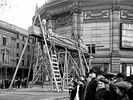Panorama (Leipzig)
The Panorama in Leipzig was a building that had existed for more than 60 years and was initially used to show panoramic images and later as a theater and entertainment venue.
Location and shape
The panorama was at Roßplatz at the confluence of Markthallenstrasse, based on today's conditions, in the eastern connection to the building of the former bowling club. The eastern neighbor of the panorama was the society house of Harmonie .
The panorama was a sixteen-sided building that appeared to be a round building, about 20 meters in diameter and roughly the same height. The actual exhibition room followed on the ground floor, which housed a large restaurant. It was windowless. A wide ring of the roof dome was glazed to illuminate the panoramic images. The visitors could not see this light source, which contributed to a more natural effect of the panorama picture. The facade was decorated with decorative elements made of light-colored stone , and the eaves were sculpted in the form of eagles and vases. In the mid- 1920s, large windows were installed in the former exhibition room to enable it to be used as an event hall . In the cellar of the house there were wine stores and tasting rooms. The complex also included a garden behind the building.
history
In 1883 the construction of a building for the presentation of panorama pictures began in Leipzig, just as it had come into fashion in other German cities for the presentation of battle panoramas after the Franco-Prussian War of 1870/71 . The construction site was on Roßplatz on the site of the former Ratszimmerhof, on which the home of the building director Johann Carl Friedrich Dauthe had stood. The opening took place on September 24, 1884. The transfer of panoramas to other, already existing panorama buildings, documented in individual cases, suggests that these buildings were designed with very similar dimensions from the start.
The Leipzig panorama showed, among other things, the pictures “The Battle of Mars-la-Tour ”, “ St. Privat ”, “The Battle of Weißenburg ” and the “ Battle of the Nations near Leipzig ”. The battle depictions also served to convey the patriotism of the visitors. In 1889 the “Panorama of Rome with Constantin's Entry in CCCXII” by Josef Bühlmann and Alexander Wagner was exhibited here, which Yadegar Asisi used as the basis for his picture “Rom312” in the Leipzig and Dresden panometers .
With the development of film into a mass medium at the beginning of the 20th century, interest in panorama presentations waned. In 1927 the Panorama exhibition room was converted into an event hall. Solo concerts and theater performances took place under the name “Künstlerspiele” or “Künstlerspiele Oswald Schlinke” (Schlinke was the host of the Panorama). Rudi Gfaller was the founder and artistic director of the Artists' Games . In the City History Museum there is a concert program in which the daily "5 o'clock tea" is mentioned. There are also pictures on old postcards showing the hall full of billiard tables. In the beer garden behind the house there were daily concerts by military bands during the summer.
The bombing raid on Leipzig on December 4, 1943 also hit the panorama. The ruin stood until the 1950s . The place has not yet been rebuilt.
See also
- Panometer Leipzig , a modern successor
Individual evidence
- ^ Meyers Konversationslexikon , Leipzig and Vienna, Fourth Edition, 1885-1892, p. 656
- ^ City Lexicon Leipzig
- ↑ Rom312 in Dresden ( Memento of 28 May 2012 at the Internet Archive )
- ↑ Stadtgeschichtliches Museum Leipzig, inventory no. A / 9134/2006
- ^ Postcard on ebay , accessed on June 4, 2012.
literature
- Horst Riedel: Stadtlexikon Leipzig from A to Z . PRO LEIPZIG, Leipzig 2005, ISBN 3-936508-03-8 . Pp. 452/453
Coordinates: 51 ° 20 ′ 8.6 ″ N , 12 ° 22 ′ 37.3 ″ E





